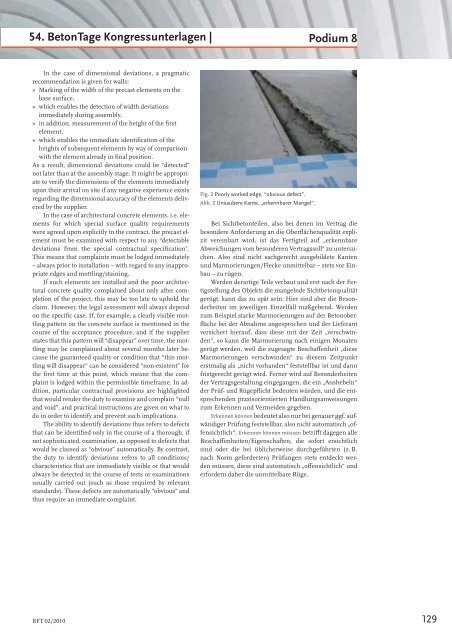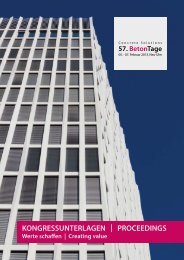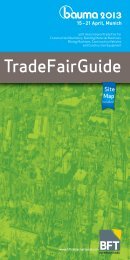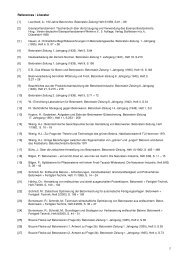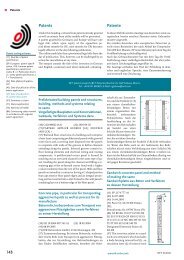Concrete Plant + Precast Technology Betonwerk ... - BFT International
Concrete Plant + Precast Technology Betonwerk ... - BFT International
Concrete Plant + Precast Technology Betonwerk ... - BFT International
Sie wollen auch ein ePaper? Erhöhen Sie die Reichweite Ihrer Titel.
YUMPU macht aus Druck-PDFs automatisch weboptimierte ePaper, die Google liebt.
54. BetonTage Kongressunterlagen |<br />
In the case of dimensional deviations, a pragmatic<br />
recommendation is given for walls:<br />
» Marking of the width of the precast elements on the<br />
base surface,<br />
» which enables the detection of width deviations<br />
immediately during assembly,<br />
» in addition, measurement of the height of the fi rst<br />
element,<br />
» which enables the immediate identifi cation of the<br />
heights of subsequent elements by way of comparison<br />
with the element already in fi nal position.<br />
As a result, dimensional deviations could be “detected”<br />
not later than at the assembly stage. It might be appropriate<br />
to verify the dimensions of the elements immediately<br />
upon their arrival on site if any negative experience exists<br />
regarding the dimensional accuracy of the elements delivered<br />
by the supplier.<br />
In the case of architectural concrete elements, i.e. elements<br />
for which special surface quality requirements<br />
were agreed upon explicitly in the contract, the precast element<br />
must be examined with respect to any “detectable<br />
deviations from the special contractual specifi cation”.<br />
This means that complaints must be lodged immediately<br />
– always prior to installation – with regard to any inappropriate<br />
edges and mottling/staining.<br />
If such elements are installed and the poor architectural<br />
concrete quality complained about only after completion<br />
of the project, this may be too late to uphold the<br />
claim. However, the legal assessment will always depend<br />
on the specifi c case. If, for example, a clearly visible mottling<br />
pattern on the concrete surface is mentioned in the<br />
course of the acceptance procedure, and if the supplier<br />
states that this pattern will “disappear” over time, the mottling<br />
may be complained about several months later because<br />
the guaranteed quality or condition that “this mottling<br />
will disappear“ can be considered “non-existent” for<br />
the fi rst time at this point, which means that the complaint<br />
is lodged within the permissible timeframe. In addition,<br />
particular contractual provisions are highlighted<br />
that would render the duty to examine and complain “null<br />
and void”, and practical instructions are given on what to<br />
do in order to identify and prevent such implications.<br />
The ability to identify deviations thus refers to defects<br />
that can be identifi ed only in the course of a thorough, if<br />
not sophisticated, examination, as opposed to defects that<br />
would be classed as “obvious” automatically. By contrast,<br />
the duty to identify deviations refers to all conditions/<br />
characteristics that are immediately visible or that would<br />
always be detected in the course of tests or examinations<br />
usually carried out (such as those required by relevant<br />
standards). These defects are automatically “obvious” and<br />
thus require an immediate complaint.<br />
<strong>BFT</strong> 02/2010<br />
Fig. 2 Poorly worked edge, “obvious defect”.<br />
Abb. 2 Unsaubere Kante, „erkennbarer Mangel“.<br />
Podium 8<br />
Bei Sichtbetonteilen, also bei denen im Vertrag die<br />
besondere Anforderung an die Oberfl ächenqualität explizit<br />
vereinbart wird, ist das Fertigteil auf „erkennbare<br />
Abweichungen vom besonderen Vertragssoll“ zu untersuchen.<br />
Also sind nicht sachgerecht ausgebildete Kanten<br />
und Marmorierungen/Flecke unmittelbar – stets vor Einbau<br />
– zu rügen.<br />
Werden derartige Teile verbaut und erst nach der Fertigstellung<br />
des Objekts die mangelnde Sichtbetonqualität<br />
gerügt, kann das zu spät sein. Hier sind aber die Besonderheiten<br />
im jeweiligen Einzelfall maßgebend. Werden<br />
zum Beispiel starke Marmorierungen auf der Betonoberfl<br />
äche bei der Abnahme angesprochen und der Lieferant<br />
versichert hierauf, dass diese mit der Zeit „verschwinden“,<br />
so kann die Marmorierung nach einigen Monaten<br />
gerügt werden, weil die zugesagte Beschaff enheit „diese<br />
Marmorierungen verschwinden“ zu diesem Zeitpunkt<br />
erstmalig als „nicht vorhanden“ feststellbar ist und dann<br />
fristgerecht gerügt wird. Ferner wird auf Besonderheiten<br />
der Vertragsgestaltung eingegangen, die ein „Aushebeln“<br />
der Prüf- und Rügepfl icht bedeuten würden, und die entsprechenden<br />
praxisorientierten Handlungsanweisungen<br />
zum Erkennen und Vermeiden gegeben.<br />
Erkennen können bedeutet also nur bei genauer ggf. aufwändiger<br />
Prüfung feststellbar, also nicht automatisch „offensichtlich“.<br />
Erkennen können müssen betriff t dagegen alle<br />
Beschaff enheiten/Eigenschaften, die sofort ersichtlich<br />
sind oder die bei üblicherweise durchgeführten (z. B.<br />
nach Norm geforderten) Prüfungen stets entdeckt werden<br />
müssen, diese sind automatisch „off ensichtlich“ und<br />
erfordern daher die unmittelbare Rüge.<br />
129


